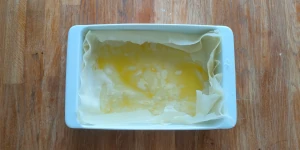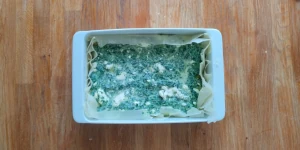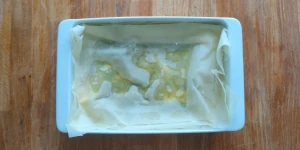
Greek Spanakopita
Jump to recipe
If you are a lover of Greek cuisine, you will definitely not miss the chance to try an authentic Greek spanakopita. This unique dish will surely appeal to anyone who likes a combination of spinach and feta cheese in a crispy, golden crust.
How was spanakopita created?
Spanakopita, known today as crispy filo pastry stuffed with spinach and cheese, comes from centuries of culinary tradition in the Balkans and the Middle East. Its roots are said to date back to the Byzantine Empire. In the 6th to 10th centuries, a technique for making paper-thin sheets of pastry, later called filo, was developed there, made from simple mixtures of flour, water, olive oil and a little yeast.
Although the Greeks had been eating a variety of flatbreads with wild herbs and vegetables since ancient times, it was only thanks to improved methods of rolling and drying filo dough that multi-layered pastries were created that could hold more moist fillings, such as lightly fried spinach mixed with local cheeses.
The real origin of spanakopita is difficult to trace, although some claim that it is of purely Greek origin and was known over 400 years ago. During the Ottoman rule of Greece, which lasted from the 14th to the early 19th century, the techniques of Turkish börek were combined with the Byzantine filo tradition, giving rise to a wide variety of filled pastries, among which the spinach pastry became particularly popular due to its simplicity of preparation and ease of transport on long trade voyages.
The classic spanakopita shape is believed to have originated in the Epirus region of northwestern Greece, particularly in the city of Ioannina, where local bakers developed a version with thicker sheets of dough and a distinct herbal flavor that became the basis for the traditional rectangular portions served at markets and family gatherings.
Although the dish has been known by many names and variations for centuries, it wasn’t until 1944 that the Merriam-Webster dictionary first recorded the term "spanakopita" as "a filo pastry stuffed with spinach." After independence in 1821, the dish became a symbol of a resurgent Greek national identity, combining traditional ingredients-fresh spinach, local feta cheese, and olive oil-in a composition that reflected the spirit of simplicity and hospitality.
In the 20th century, with the mass migration of Greeks to Europe, North America and Australia, tasty pieces of spanakopita spread beyond their homeland, becoming an appetizer and street food available in Greek cafes around the world.
Today, spanakopita comes in many varieties, from traditional rectangular pieces to elaborate triangular envelopes, and each region of Greece and almost every family has its own slight variation on this classic recipe, proving that the simplicity of filo and spinach has inspired generations of cooks.
How to prepare a spanakopita?
Preparing Greek spanakopita is not difficult at all. You just need to stock up on the right ingredients, and the rest will go downhill. Preparing spanakopita requires only a few simple steps: preparing the filling, gently arranging subsequent layers of filo with the addition of olive oil or butter, and then baking, which gives the baked product a golden and crispy structure. Thanks to its lightness and expressive flavors, spanakopita is perfect both as a snack for family gatherings and as an elegant appetizer.
Recipe informations:
Ingredients

- 300 g - phyllo dough (7-8 slices)
- 350 g - Spinach (preferably fresh)
- 3 eggs
- 250 g Feta Cheese
- a few sprigs of dill or parsley, chopped
- salt and pepper to taste
- olive oil
Steps
1. Step

2. Step

3. Step

4. Step

